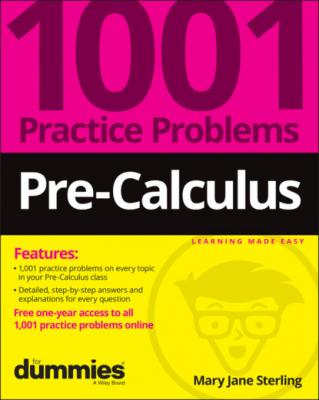Pre-Calculus: 1001 Practice Problems For Dummies (+ Free Online Practice). Mary Jane Sterling
Читать онлайн.| Название | Pre-Calculus: 1001 Practice Problems For Dummies (+ Free Online Practice) |
|---|---|
| Автор произведения | Mary Jane Sterling |
| Жанр | Математика |
| Серия | |
| Издательство | Математика |
| Год выпуска | 0 |
| isbn | 9781119883647 |
19. If x = 3 and y = x, then y = 3.
20.
Simplifying Expressions with the Order of Operations
21–30 Simplify the expression by using the order of operations.
21.
22.
23.
24.
25.
26.
27.
28.
29.
30.
Graphing Inequalities
31–40 Graph the inequality.
31.
32.
33.
34.
35.
36.
37.
38.
39.
40.
Using Graphing Formulas
41–50 Solve by using the necessary formula.
41. Find the slope of the line through the points (−2, 3) and (4, 9).
42. Find the slope of the line through the points (−4, −3) and (−6, 2).
43. Find the slope of the line through the points (4, −3) and (4, −7).
44. Find the slope of the line through the points (−2, −9) and (2, −9).
45. Find the distance between the points (−8, −1) and (−2, 7).
46. Find the distance between the points (0, 16) and (7, −8).
47. Find the distance between the points (6, −5) and (−4, 3).
48. Find the midpoint of the segment between the points (−5, 2) and (7, −8).
49. Find the midpoint of the segment between the points (6, 3) and (−4, −4).
50. Find the midpoint of the segment between the points
Applying Graphing Formulas
51–60 Use an appropriate formula to compute the indicated value.
51. Find the perimeter of triangle ABC, whose vertices are A (1, 1), B (1, 4), and C (5, 1).
52. Find the perimeter of the parallelogram DEFG, whose vertices are D (0, 10), E (9, 13), F (11, 7), and G (2, 4).
53. Find the center of the rhombus HJKL, whose vertices are H (0, 3), J (4, 6), K (8, 3), and L (4, 0).
54. Determine which type(s) of triangle ABC is if the vertices are A (1, 1), B (4, 5), and C (9, −5).
55. Determine which type of triangle ABC is if the vertices are A (0, 0), B (0, 12), and C
56. Find the length of the altitude of triangle ABC, drawn to side AC, with vertices A (0, 0), B (5, 12), and C (21, 0).
57. Find the length of the altitude of triangle DEF, drawn to side DF, with vertices D (2, 3), E (2, 12), and F (42, 3).
58. Find the area of the parallelogram PQRS with vertices P (4, 7), Q (7, 12), R (15, 12), and S (12, 7).
59. Find the area of circle A if the endpoints of its diameter are at (6, 13) and (−8, 21).
60. Find the area of triangle ABC with vertices A (0, 0), B (5, 12), and C (14, 0).
Chapter 2
Solving Some Equations and Inequalities
The object of solving equations and inequalities is to discover which number or numbers will create a true statement in the given expression. The main techniques you use to find such solutions include factoring, applying the multiplication property of zero, creating sign lines, finding common denominators, and squaring both sides of an equation. Your challenge is to determine which techniques work in a particular problem and whether you have a correct solution after applying those techniques.
The Problems You’ll Work On
In this chapter, you’ll work with equations and inequalities in the following ways:
Writing inequality solutions using both inequality notation and interval notation
Solving linear and quadratic inequalities using a sign line
Determining the solutions of absolute value equations and inequalities
Taking on radical equations and checking for extraneous roots
Rationalizing denominators as a method for finding solutions
What to Watch Out For
Keep in mind that when solving equations and inequalities, your challenges will include
Factoring
